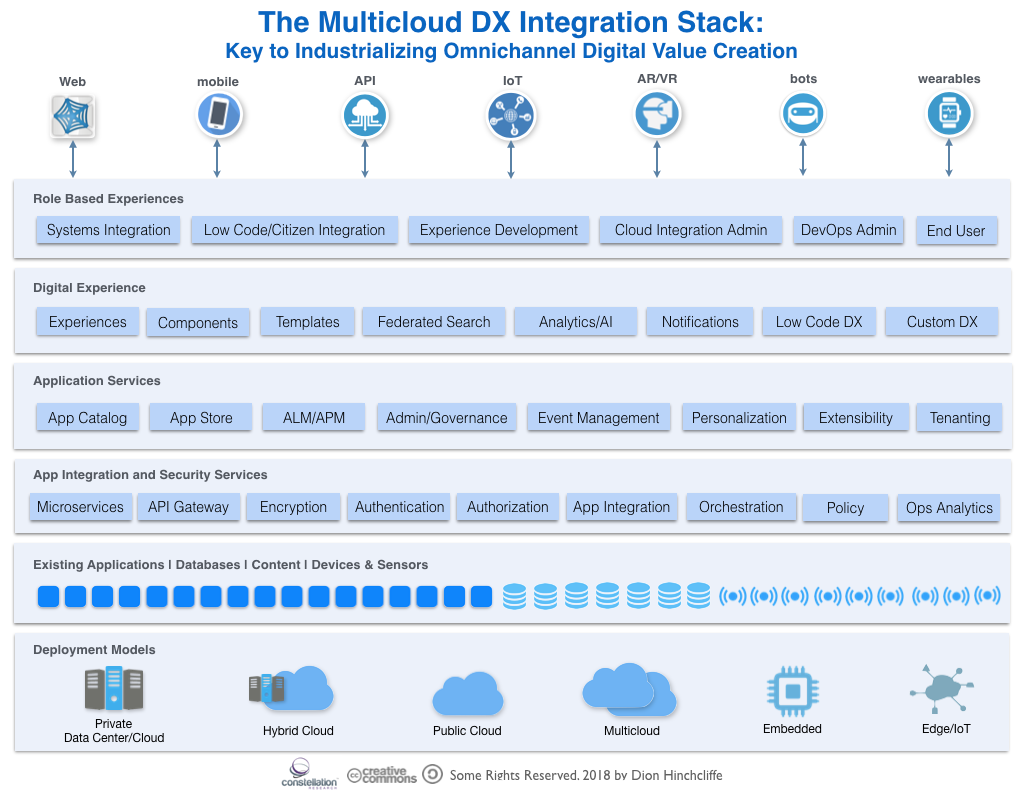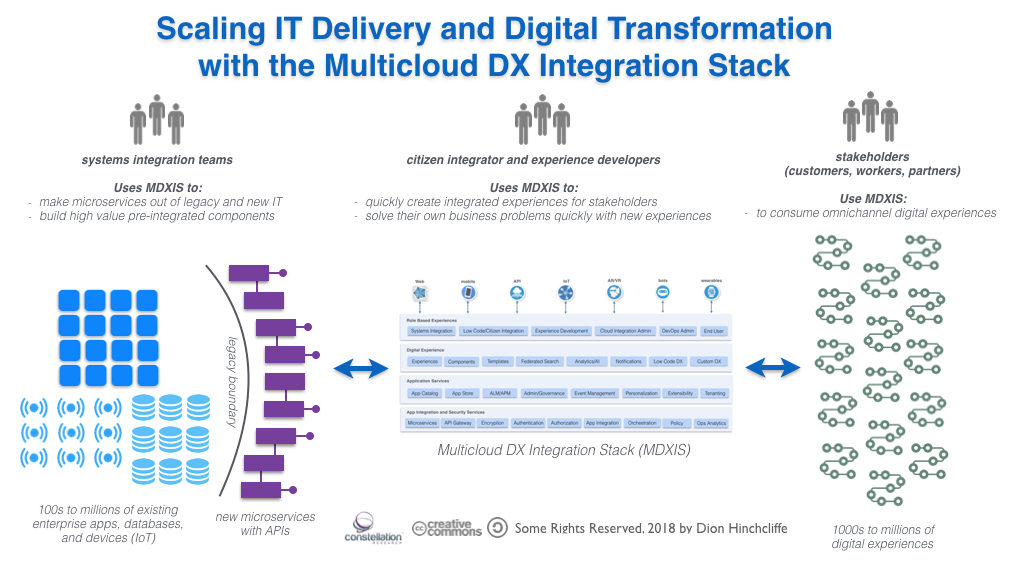For many organizations, it has become clear that they're falling behind in the digital race and the data has long shown this. There is simply too much to digitize, too many points of integration, too many apps, too many channels, too much data and not enough time or resources. And don't forget a growing amount of technical debt and what I have called legacy IT mountain, namely the accumulation of all the enterprise infrastructure, systems, and data currently in operation to date. These drain invaluable budget, time, and energy away from much needed net new digital outcomes.
IT departments, digital divisions, and marketing technology teams – the three major groups that are struggling most – simply can't move fast enough to meet today's fast-paced and broad-based demands for new digital solutions and experiences that are highly integrated and personalized. At least, not structured and tooled the way they are today.
The industry has responded to this challenge in some ways however. One trend is DevOps, which aims to solve the collaboration gaps preventing faster and more agile joint functioning of development and operations teams in highly iterative and responsive ways. Microservices and APIs are another way that organizations are making IT more readily composable, malleable and easier to consume, giving rise to the realization of a better Digital Core that will fuel a more responsive, data-driven, recombinant, self-service, and experience-centric digital delivery model. Microservices in fact have arguably become the flexible business architecture that orgs have long sought. Consequently, they are the strongest target architecture model we know of today. Finally, low code tools have matured to the point than in the last two years it's finally been possible to get 5x and even 8x productivity gains in remixing microservices into on-demand digital experiences.
But as important advances as they are, DevOps, microservices/APIs, and low code tools are just enablers. They aren't digital solutions themselves and can't directly realize value creation. And certainly not at scale using the way most digital units are organized today in terms of structure, process, and tooling. We must somehow marshall our limited delivery bandwidth to be much more efficient and productive using these methods.
So while these are laudable shifts in the IT and digital industry, they are not enough. Backlogs are a major issue in most organizations and must be reduced if digital teams are to stay relevant. Organizations have to actually move much faster than they are today to meet stakeholder needs. To do so they need to offer ready access to all applications, enterprise systems, their data, and devices, combined with the simpliest and most powerful way to turn these vital digital assets into new experiences. And experiences means value, as digital experience is the most important boundary across which business value is delivered and captured with stakeholders today, both within and outside our organizations.
What's really needed is a truly agile cloud-native capability that can strategically aid organizations in building a strong architectural and data foundation using microservices and APIs, then quickly and securely expose them for knitting together into experiences that meet business requirements. And to enable this in a truly industrial scale fashion. That's because most organizations now have what I like to call a Tesla manufacturing problem (referring to the tremendous scale up and now-famous difficulties therein in mass manufacturing their first mainstream car, the Model 3.) Many of us have suddenly found ourselves in a position where there is similar skyrocketing demand for our digital offerings. But we don't have a good way to take our IT assets and make the key value creating artifacts, the digital experiences, nearly fast enough or robustly enough (fully omnichannel, deeply integrated, automated, and data-driven.)
For lack of a better term – there are certainly others being bandied about, for this is far from a unique realization in the industry – I am calling such a capstone digital delivery enabler a Multicloud Digital Experience (DX) Integration Cloud or MDXIS.
Each word is very important in this term. It must be multicloud because such a platform must be able to reach digital systems and data wherever they reside, no matter the location. The end goal of the platform is the last mile and most important step of digital value creation, digital experiences. It's about integration of digital assets within those experiences, because deeply connected solutions is now one of the most difficult challenges and largest opportunities in technology and business today. Finally, it's a stack in the true sense, from low-level services and infrastructure at the bottom to the high-value outcomes at the top.
The MDXIS can be built or bought, and some organizations will do some of both, and may have to do both because few vendors are – or can, given the number and complexity of integration scenarios in particular – offer a one-stop-shop yet. However, it's this robust capability or some close version of it that enterprises will need to acquire and wield to overcome the current shortfall in their "manufacturing capacity." Because we now find ourselves in a stakeholder market much hungrier and expectant today for rapidly delivered, personalized, omnichannel digital experiences that meet their needs, whatever they are. Organizations that can marshall such a platform will be able to meet business challenges far faster, more reliably, more repeatably and at much higher scale to capture opportunity and marketshare faster than those who do not have such scaled assembly lines.
There are five layers (a sixth is the existing applications, databases, content, devices themselves, but for simplicity, we'll consider them external) to the MDXIS stack that must be fully realized in order to get the high throughput and maximum number of experiences per integrator/developer unit of time.
The first and bottom layer of MDXIS is the support for a robust number of deployment models, from private cloud and on-premesis all the way out to public cloud, the edge, and Internet of Things (IoT), even embedded systems as necessary. The second layer is the delivery of a well-design and managed set of business-level microservices exposed by APIs in a fully secure and policy-driven way. The third layer is application services that organize existing experiences using a catalog and app store model (used to self-service as well as provision parts of MDXIS for partner/supplier use, etc.), as well providing lifecycle and performance management, personalization capabilities, extensibility, automation, and event services. The fourth layer consists of digital experience functions including experiences themselves, components (re-usable experience parts), templates for common types of business scenarios (sales, project management, operations, e-commerce, marketing, etc.), federated search, analytics/AI, low-code tools, and the ability to create custom experiences by hand for unique situations. The fifth layer is made up of role-based experiences that enable rapid systems integration of existing IT assets into a consistent microservices architecture, low-code/citizen developer integration tools, experience development tools, a cloud integration admin experience for administering the entire industrialized capability, devops support, and as well as the end-user experiences themselves, the ultimate output of the exercise.
There are plenty of more details that should be understood, but I'll be covering these in an upcoming report that explores the MDXIS in far more detail. For now, it's enough to know that most organizations badly need this capability and that it's what's missing to deliver operationally on key parts of digital transformation (assuredly, it must be hand-in-hand with the softer critical elements like culture change and education.) The CIO and CDO in most organizations will likely own the MDXIS but it's likely to have the CMO as one of its great supporters. Because make no mistake, this capability can really only be achieved by a member of the C-Suite that can force other operating silos and apps owned across the organization to participate. That's because any part of the organization that can opt out of participating will greatly diminish the value of such a stack. It's exciting that we seem collectively to have a much better understanding of one of the missing pieces for digital leadership. The MDXIS is a critical element to raise the maturity level of most digital efforts.
Note: I am currently building a shortlist of existing and emerging new players in this space for those interested to evaluate. Note that MDXIS is different that my Digital Transformation Target Platforms and to Ray Wang's Digital Experience Integrated Platforms shortlists for several key reasons, not the least that most of the tools on both those lists don't qualify. That's because MDXIS platforms put a) an overarching emphasis on microservices as the main enabling business architecture to build the strongest composable and future-ready enterprise-wide digital core based on all IT and content assets of every flavor, b) primary emphasis on low code to enable high scale integration and experience creation by anyone, especially local digital change agents, and c) a relentless focus on high integration/developer throughput across the stack, at least a 5x improvement.
A very initial list of qualifiying MDXIS players for now, which some currently call iPaaS (but again, doesn't always emphasize the essential capabilities above), which I'll expand soon is as follows:
- TIBCO Cloud Integration
- Outsystems
- Jitterbit
- Mulesoft + Appian (overview)
- Warewolf + Low Code DX Tool / ALM
- Built.io
- AlohaDXP
I do reserve the right to change this list as we learn more. If you have others to add to this list, please contact me, but do explain how it hits each of the points above.




